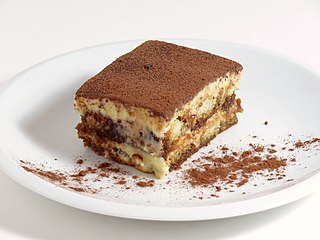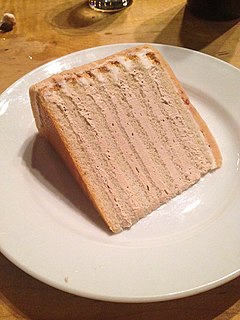
Supangle or sup is a type of Turkish chocolate pudding. Its bottom layer includes pieces of cake and it is often garnished with pistachio or coconut, and chocolate chips.

Supangle or sup is a type of Turkish chocolate pudding. Its bottom layer includes pieces of cake and it is often garnished with pistachio or coconut, and chocolate chips.
The name supangle comes from soupe anglaise, French for English soup. [1] It can be thought to be the literal translation of the name of the Italian dessert Zuppa Inglese, but Zuppa Inglese is known by its Italian name in France and the name soupe anglaise is not used. Despite the possible etymological link, the dessert supangle bears no resemblance to zuppa Inglese other than the inclusion of cake under a creamy pudding. [2]
Supangle is cooked from milk, sugar, flour, and cocoa powder, with butter and chocolate added. The bottom layer of supangle consists of cake, cookie, or biscuits, for which leftovers may be used. [2] Eggs and hazelnut chocolate spread (e.g. Nutella) are also used in some recipes. [3] It is decorated with ground pistachio or shredded coconut and served cold. Serving it with ice cream is also growing in popularity. [4]

Dessert is a course that concludes a meal. The course consists of sweet foods, such as confections, and possibly a beverage such as dessert wine and liqueur. In some parts of the world, such as much of Central Africa and West Africa, and most parts of China, there is no tradition of a dessert course to conclude a meal.

Tiramisu is a coffee-flavoured Italian dessert. It is made of ladyfingers (savoiardi) dipped in coffee, layered with a whipped mixture of eggs, sugar, and mascarpone cheese, flavoured with cocoa. The recipe has been adapted into many varieties of cakes and other desserts. Its origins are often disputed among Italian regions Veneto and Friuli Venezia Giulia.

Trifle is a layered dessert found in British and other cuisines. Made with a thin layer of sponge fingers commonly soaked in sherry or another fortified wine, custard and a fruit element, the contents of a trifle are highly variable; many varieties exist, some forgoing fruit entirely and instead using other ingredients, such as chocolate, coffee or vanilla. The fruit and sponge layers may be suspended in fruit-flavoured jelly, and these ingredients are usually arranged to produce three or four layers. The assembled dessert can be topped with whipped cream, or, more traditionally, syllabub.

Rice pudding is a dish made from rice mixed with water or milk and other ingredients such as cinnamon, vanilla and raisins.

A mille-feuille ,, also known by the names Napoleon, vanilla slice, and custard slice, is a pastry whose exact origin is unknown. Its modern form was influenced by improvements made by Marie-Antoine Carême.

A Swiss roll, jelly roll, roll cake, cream roll, roulade or Swiss log is a type of rolled sponge cake filled with whipped cream, jam, or icing. The origins of the term are unclear; in spite of the name "Swiss roll", the cake is believed to have originated elsewhere in Central Europe, possibly Austria or Slovenia. It appears to have been invented in the nineteenth century, along with Battenberg cake, doughnuts, and Victoria sponge. In the U.S., commercial versions of the cake are sold with the brand names of Ho Hos, Yodels, Swiss Cake Rolls, and others. A type of roll cake called Yule log is traditionally served at Christmas.

A Boston cream pie is a cake with a cream filling. The dessert acquired its name when cakes and pies were cooked in the same pans, and the words were used interchangeably. In the late 19th century, this type of cake was variously called a "cream pie", a "chocolate cream pie", or a "custard cake".

A génoise, also known as Genoese cake or Genovese cake, is an Italian sponge cake named after the city of Genoa and associated with Italian and French cuisine. Instead of using chemical leavening, air is suspended in the batter during mixing to provide volume.

Zuppa Inglese is an Italian dessert layering custard and sponge cake, perhaps derived from trifle.

An icebox cake (American) or chocolate ripple cake or log (Australian) is a dessert typically made with cream, fruits, nuts, and wafers and set in the refrigerator. The term can refer to a general category of dishes that involve the same process, and one particularly well-known version is the back-of-the-box recipe on thin and dark Nabisco Famous Chocolate Wafers.

Doberge cake is a layered dessert originating in New Orleans, Louisiana, adapted by local baker Beulah Ledner from the Hungarian Dobos torte. Still popular in the area, the cake is made of multiple thin layers of cake alternating with dessert pudding. Very often the cakes are made with half chocolate pudding and half lemon pudding. They are covered in a thin layer of butter cream and a fondant shell or, alternatively, a poured glaze on the outside. They are normally made with six or more layers. Traditional flavors are chocolate, lemon or caramel.

Ekmek kadayıfı is a bread pudding that was historically part of Ottoman cuisine and in modern times remains part of the cuisines of the former Ottoman Empire. It is usually served with kaymak, a kind of clotted cream. In Turkey it is considered a regional specialty of Afyonkarahisar.

Sponge cake is a light cake made with egg whites, flour and sugar, sometimes leavened with baking powder. Sponge cakes, leavened with beaten eggs, originated during the Renaissance, possibly in Spain. The sponge cake is thought to be one of the first of the non-yeasted cakes, and the earliest attested sponge cake recipe in English is found in a book by the English poet Gervase Markham, The English Huswife, Containing the Inward and Outward Virtues Which Ought to Be in a Complete Woman (1615). Still, the cake was much more like a cracker: thin and crispy. Sponge cakes became the cake recognized today when bakers started using beaten eggs as a rising agent in the mid-18th century. The Victorian creation of baking powder by English food manufacturer Alfred Bird in 1843 allowed the addition of butter to the traditional sponge recipe, resulting in the creation of the Victoria sponge.

Muhallebi is a milk pudding commonly made with rice, sugar, milk and either rice flour, starch or semolina, popular as a dessert in the Middle East. While the dessert is called Muhallebi in Turkey and Iraq, the Egyptian variant is called Mahalabia, the Lebanese and Syrian variant is called Mahalayeh, and the Israeli variant is called Malabi.

Kue lapis is an Indonesian kue, or a traditional snack of steamed colourful layered soft rice flour pudding. In Indonesian lapis means "layers". This steamed layered sticky rice cake or pudding is quite popular in Indonesia, Suriname and can also be found in the Netherlands through their colonial links. Kue lapis is also very popular in neighbouring Malaysia, Singapore, and Brunei where it is called kuih lapis. Kue lapis was introduced by the Sino-Burmese to Lower Myanmar, where it is known as kway lapay (ကွေလာပေး) or kway lapaysa (ကွေလာပေးစ).